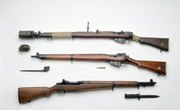The M4 is the current issue rifle of the U.S. military. The rifle is based on the design of the M-16 and has many of the same features. The military procures scopes from a variety of suppliers including some of the finest manufacturers of scope technology in the world. There are a variety of types of scopes used by the military today.
Red Dot Scopes
Red dot scopes are designed to quickly acquire and engage targets at short ranges, or what the military calls close quarter combat (CQC).Red dot scopes typically do not magnify the target, but feature a red point of light that is only visible when looking through the scope. The light intensity is adjustable and the point of light appears exactly like a laser beam; however, unlike a laser beam, red dot scopes function well in daylight. Red dot scopes are powered by lithium batteries.
Holographic Scopes
Holographic sighting systems are similar to red dot scopes in that they do not magnify the target and are designed to quickly engage targets. Holographic sights feature a window with holographic reticles. The sights are also very effective for close quarter combat scenarios. Like the red dot scopes, holographic scopes are powered by lithium batteries.
Fixed Power Scopes
Fixed power scopes are preset to a specific magnification; typical among M4 rifles are four powered scopes. The Advanced Combat Optical Gunsight, or ACOG, is a particularly popular scope with the military; this fixed power scope features reticles that allow the shooter to quickly adjust for range without having to make any calculations for bullet drop. Variations of fixed power scopes are commonplace on M4 rifles.
Variable Power Scopes
The military also utilizes variable power scopes on its M4 rifles. These versatile scopes can be quickly adjusted from short to longer range shooting. A common variable power scope is the 3 to 9 power that allows the shooter to adjust the scope's power from three times your normal vision to nine times. Most variable power scopes used by the military also feature ranging marks on the reticles that can be used for estimating distance.
References
Writer Bio
Peter Timm has been writing since 2002 for both print and online publications. Timm earned a Bachelor of Arts from the New York Institute of Technology in 2008 and emerged a technically astute writer.



